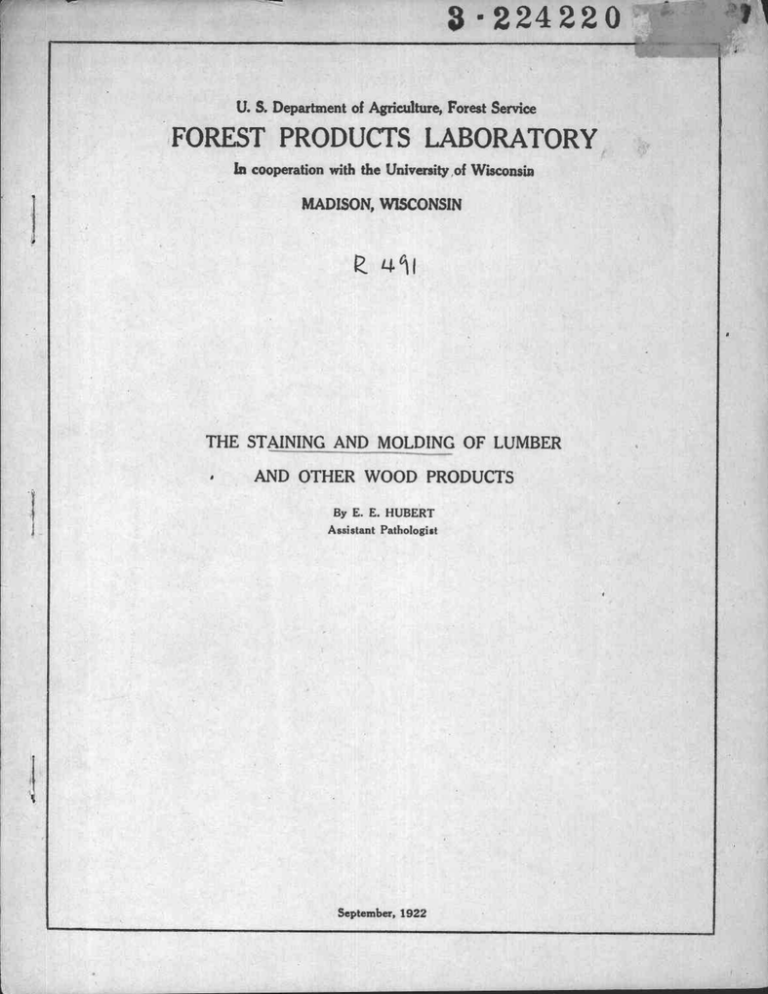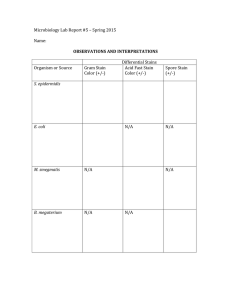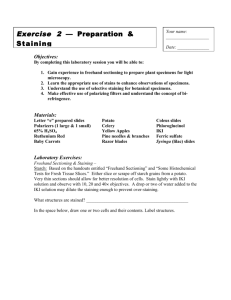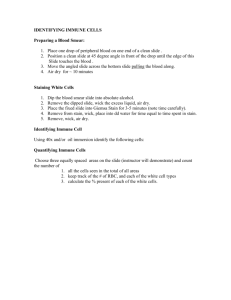3 . 22422 0 FOREST PRODUCTS LA
advertisement

3 . 22422 0 U. S. Department of Agriculture, Forest Service FOREST PRODUCTS LA THE STAINING AND MOLDING OF LUMI3ER THE STAINING AND MOLDING OF LUMBE R AND OTHER WOOD PRODUCT S Ernest E . Hubert , Assistant Pathologis t Bureau of Plant Industry in Cooperation with Forest Servic e Forest Products Laborator y Most of the discolorations or stains prod .us ) grade in lumber and other wood products are caused by o rt'-r l organisms of the lower forms of plant life known as f-ur i This type of stain is the most important economically anJ s very widespread, causing an annual loss which amounts to several millions of dollars . The other type of stain believe d to be due to chemical reactions is not so common but ',evertheless causes considerable loss due to degrade . Stains Chemically Produce d There are several brownish to yellowish stains foun d in pines and in hardwoods which are apparently p roduced b y ferments within the wood . Some of these stains ap p ear in log s stored for a considerable period in the mill pond, whil e others develop during kiln drying or air seasoning . Th e stains developing in the kiln can in some cases be wholly o r p artially prevented by comparatively low kiln temperature s (120-130° F .) accompanied by low humidities of 60 per cent o r less . Those developing soon after sawing and said to b e caused by ferments can often be prevented by dipping the gree n lumber in boiling water to kill the ferment . The yellowish to brownish stains common in suga r pine and western yellow pine seem to differ somewhat in thes e two woods . In western yellow pine the stain does not penetrate deeply in the sapwood and can usually be planed off , while in the sugar pine the stain penetrates deeply in both heartwood and sapwood and is most pronounced at the junctur e of the two . This "kiln burn" type of stain in western yello w pine should not be confused with a much darker, patchy "brow n stain" of the sapwood and heartwood caused by a fungus . Great care is needed in differentiating between stains produced b y chemical action and those produced by fungi . Stains Produced by Fung i The stains caused by fungi vsry in color from yellow, pink, red, brown, blue and green to black . In general these stains are due to the growth within the wood of minut e threads of fungi . These fungi are very small plants whic h secure their nourishment from the wood they inhabit, feedin g principally upon the starches, sugars, and other cell conteoT a As they develop they find means of progressing from one woo d cell to another, usually through the thin parts of the cel :° walls but occasionally boring through the wall of the woo d fiber . The conditions for the rapid development of fungou s stains are essentially the same as for the development of tru e wood-destroying fungi . These stain fungi require an abundan t f :od supply, a comparatively high moisture content of th e wood and warm weather . Stains due to fungi are always wors e during rainy periods in the warmer seasons of the year, whe n the air is very humid and the wood dries correspondingly slowly . Very severe staining may occur under such conditions , particularly if the Stock is taken fresh from the saw an d piled in bulk or without ample ventilation between the boards . Most staining or molding develops at the mill, or in ' .'?nsi t when the lumber is close piled in oars or in the held c r ships . Mute" staining and molding often develops on wet stook ,;'ace d in storage and not properly piled or ventilated . During th e warm humid months stain may appeer in logs or in lumber an d other products within 24 to 48 hours after cutting, but develops much slower during the cooler months of the year . Although stain does not materially affect the mechanical properties of wood for general commercial uses, i t should not be present in excessive amounts, since the conditions which permit the luxuriant development of mold an d stains also offer the opportunity for infection with wood destroying fungi . Moreover, an undue amount of stain indicates a . high percentage of sapwood, which is not desirable , as a rule, in structural timber on account of its low resistance to decay . R491 -2- Molding and staining do not + :a= :'ly affect th e strength properties of rood but the vral-ut • o tai+ e= ■wood i s lowered for use where disolorations' are objectionable . Where the wood is to receive a natral finish, fungus stain s are obviously objectionable . Bright stock free of stain i s always demani'ed- i-n certain grades of basket and ox veneers , cooperage, b e boards, veneer, vehicle,, lumber, *i ;ee,sio n stock and timbers for export, and a long list of other products . Where the discoloration is to be c,ov:ered up o r painted and where the use of sapwood is not objectionable , there is no reason for discriminating against it providin g no wood-destroying fungi are associated with the stainin g organism . Exceptions to this occur in airplane and simila r stock requiring maximum strength . ';where sapwood is accept able, and the customer is not prejudiced against stain, a large amount of stained stock can be used in the manufactur e of sash, door, millwork, and a great variety of other wood , products which are to be covered with paint . Many of the staining organisms belong to a lar+g e group of fungi commonly termed molds . The molds in ger;al produce staiAe wh4ch rarely penetrate deeply into the wood . Such stains as the yellow stain of oaks and other haTdwoo .ds ; and the grayish-olive stain of hardwoods penetrate the" wood . to a considerable depth, and cannot readily,be dressed off . . However, there are a large number of the common black, gree n and pink molds producing superficial stains which are , most cases, Teadily planed off the boards . Products from th e cooperage, box, . veneer, vehicle and other industries suffe r greatly in degrade due t o - the development of molds and stars upon them . Mold stock should not be made a - part of wood co+tainers used in transporting perishable' foodstuffs on aco,an t of the danger of contamination . • The brown stain of white pine and yellowpine,-The brown stain or "scorch" stain has been found to discolor th e best grades of sugar pine, eastern white pine and western yellow pine lumber and considerable loss in degrade has resulted . The "scorched" areas are somewhat irregularly distributed throughout the sapwood and heartwood and the'eoler-s of the patches and streaks range from a light yellowish brow n to a rich dark brown, sometimes approaching black . The streak s are sometimes narrow, extending some distance along the grai n of the wood . The discoloration is due to a fungus present i n the wood and is very difficult to distinguish from the 7ehem- ically produced brown or yellow stains of sugar pine'and west ern yellow pine . R491 Bluestain .--Blue stain is common in the sapwood o f large number of woods, both of the hardwood and the softwoo d a groups . The fungus causing the stain grows rapidly and stai n may appear in a log or board soon after it is cut . The minut e threads of the fungus in the wood tissues are responsible fo r the blue-gray discoloration . When these threads, feeding o n the contents of the wood cells and to a slight extent on th e cell walls, reach a certain stage in their development, fruiting bodies are produced upon the surface of the wood . Thes e fruiting bodies appear as minute black specks upon the blue d wood, and under a magnifying glass are seen to resemble smal l black hairs or bristles swollen at the base . These black , flask-like bodies contain the minute spores which whe n ejected are carried about by the wind and other agencies an d are capable of germinating and causing new blue-stain infections . Blue stain at first appears in spots or streaks . Later as the fungus develops deep in the wood, the entire se-p a wood may be discolored . In this stage it cannot be surface d off . When there is not sufficient moisture, the blue stai n fungus_becomes inactive and can remain dormant in the wood fo r long periods of time . When favorable moisture conditions re turn it revives and continues its growth . The bearing of thi s fact on the piling of lumber for air seasoning or for storag e is self evident . Boards cut from the sapwood of slightly blue d .' ugs should be stored and piled so that further growth of th e fungus will be checked by rapid drying . Otherwise the blu e stain will spread . It is equally important to keep the stoc k cry once it has been properly seasoned, for the fungne wil l revive and continue to spread as long as sufficient moistur e is present . The "souring :+ or "fermenting" of the sap heL n been given as the direct cause of blue stain . The a * cause, however, is the blue-stain fungus present in , he wood . This fungus grows best on substances which contain some acid , and the acid or sour sap, particularly in such woods as sa p gum, makes conditions very favorable for rapid development . This is the reason alkaline dips are used in the preventio n of sap stains for the acid condition is neutralized and th e conditions are then no longer favorable for this development . r Prevention of Staining and Moldin g There are three possible methods of combating stain s and molds on wood, as follows : Air seasoning, kiln drying an d treatment with antiseptic solutions . R491 -4- tai n VMOO;; 1714 wr 44tolyp+ invest4&443 .1,14 control , ., i. . , ann. MloXd kAoV.e JFO&o k4 #dal* t4 The reader is referred to tic following paper, available a t the Laboratory on request :yng tests for control of sa p stain, mold, and decay in samu++eno fiber and logs, by T . C . Scheffer and A . D . Chapman . ,~ .7 1 i V 11 U Air seasoning .--Air seasoning, when it can be employed effectively, is believed by many to be the cheapes t method to use . Climatic conditions strongly influence th e effectiveness of this method . Rapid handling from the tim e the tree is cut until the lumber is properly stacked in th e yards will greatly aid in reducing if not preventing thes e defects which appear in the stacked material . The pilin g methods used should afford the maximum of air circulatio n about the boards and about the piles . Kilndrying .--Kiln drying annesrs to be an effe :-tive method of control, although if low temperatures ar e used the molding fungi which are more resistant to heat ma y develop in the kiln . It has been determined through tests that a temperature of 140° F . maintained for three hours at saturate d atmosphere kills the blue stain fungus in 1-inch and 2-inc h stock but not in 4-inch stock . In six hours under the abov e conditions, the fungus was killed in•all three sizes . Ternperatures and humidities used in several commercial kil n runs have also been found effective in killing this fungu s in 1, 2 and 4-inch stock . Ordinary kiln drying should there fore be effective in killing this fungus and preventing it s Ce lopment, providing the stock is kept in a dry, sanitar y c edition curing subsequent storage . In general, steamin g te- stock at 170° or 180° F . for a period not exceeding an hc)c will stop the growth of mold . This treatment heat s t Al surface of the stock sufficiently to kill the mold'', and a-r the same time too rapid drying is prevented by th e sLcuiated air . The process of steaming lumber followed Tl seasoning has in many cases given good results in :i is seasoning the stock and in preventing, to a considerable ex tent, the development of stains and molds . However, unde r unfavorable weather conditions and improper steaming th e stock often stains and molds during air-seasoning . The blue-stain fungus is killed when present in 4/4 gum board s steamed under pressure of 30 pounds for 40 minutes . Antiseptic treatment .--The antiseptic treatmen t of wood with solutions to prevent staining and molding ha s been practiced for some time with varying degrees of success . Sodium carbonate (soda ash) and sodium bicarbonate (bakin g soda) are the chemicals most commonly used in this metho d of control, which consists in chemicsl or hand dipping th e stock as it comes from the E?w in a heated chemical solution . Neither of the two chemicals mentioned is a perfec t preventative under severe conditions, such as continuou s rainy periods during the warmer months, but either will g o far toward keeping the stock clean . In rainy seasons an 8 per cent solution of sodium carbonate is desirable . In drie r weather half this should suffice . A high grade of soda as h should contain about 58-1/2 per cent alkali and every effor t should be made to conform to this standard of purity . When sodium bicarbonate is used, an 11 per cent solution should b e employed in wet weather and 5 to 6 per cent in dry weather . This chemical, when dry and pure, should contain about 3 7 per cent alkali . There are other chemical dips which have been employed under semi-commercial conditions, the most promisin g being mercuric chloride (corrosive sublimate) and sodium fluoride . The former gave excellent experimental result s in a 0 .1 per cent solution but on account of its highl y poisonous character its general use is not recommended . Sodium fluoride in a 3 per cent solution can be used success fully against blue stain but has not given completely satisfactory results, under severe conditions, against molds . 4 In the use of these chemical dips, the followin g p oints should be kept in mind : (1) The solutions sl-o :l c b e o'efully mixed and the concentrations in the dippil_ tank s , : )uld be kept uniform by means of a hydrometer . (2) Th e s)lutions should be heated when applied, the bicarbonat e :Lution not above 120° F ., however, because it is broken . ,i )wn into the carbonate by excessive heating . (3) The crock should be dipped as it comes from the saw . (4) After d ypin g it should be carefully piled so as to insure ample venilation . Narrow, chemically-treated cross strips are preFer_- able to the wide untreated strips commonly employed, ae s treated crossers tend to eliminate stain at the poin t contact . It is evident that the conditions under which th e stock is stored after treatment are highly important factor s in the control of stain . Proper methods of piling and protection of stored material against moisture are vital point s to be considered in preventing stain . The cost of mechanical dipping of lumber shoul d not exceed 10 to 12 cents per M board feet at the 192 2 prices of chemicals . There is at present no perfect method for control ling the staining and molding of wood . However, experiment s are in progress aiming at finding better methods of prevention . R491 -6- 1 1 SIMARY There are two types of wood stains : (1) those due to purely chemical reactions in sound wood ; (2) those produced by fungi . The latter are by far the most important and affect a large number of different ' woods, hardwoods as well a s conifers . Most of the mold stains are superficial and readily surface off, but the "blue stain" often discolors th e entire sapwood and is hence the most conspicuous on dresse d lumber . Sap-stained wood can be used for ordinary commercial use when its appearance is not objectionable, wher e it is to be covered up or painted over or where durabilit y in respect to decay or where strength is not of prime i m _ portance . The chemical stains are limited to a comparativel y few kinds of timber and usually penetrate deeply both th e sapwood and heartwood . Neither fungus stains nor chemical stains weake n . tb,, timber to any appreciable extent . However, a luxurian t C.c 3lopment of fungus stain implies that the timber has bee n piled in a moist, poorly ventilated condition which als o favors infection with true wood-rotting fungi . Fungus stain can be prevented by kiln drying o r can be largely controlled by open piling in air drying, o r better, by dipping the fresh stock in antiseptic solution s and then piling properly . 1 Chemical stains can be largely prevented by maintaining low temperatures and low humidities in the dry kil n during the conditioning process . In air-seasoned stock , the ferments causing stain may be killed by dipping in boiling water . 11r • : _ •. .. 1~ :. R491 X 11 1 II 71 :c,r 1 V r •a s ' l r: 1 .i s n u r L,e II II I . I II II ' " -i :1 4 1 •1





